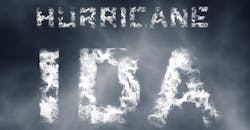Four Ways You Can Help with Hurricane Ida Recovery
By now you’ve all had a chance to see the details from Hurricane Ida’s landfall on Sunday, the 16th anniversary of Hurricane Katrina, as a strong Category 4 storm. Thus far, it has left more than a million people without power, created significant damage, blocked many transportation routes and put countless people in need of rescue. And based on its current track and still-powerful strength, we’re not out of the woods yet.
Our team at American Logistics Aid Network (ALAN) continues to track impacts as Ida moves to the northeast where it is forecast to bring heavy rains over the Tennessee and Ohio valleys, central and southern Appalachians, and the Mid-Atlantic through Wednesday.
But even in the midst of all of this bad news, there are still several things we can be thankful for.
For one thing, the levees that failed during Hurricane Katrina held. For another, countless first responders and relief organizations like ALAN are already hard at work delivering help and hope.
Just as important, we here at ALAN know that we can count on all of you. Over the past few days, we have been heartened to hear from many of you, who have asked us some variation of the question, “What can we do?”
ALAN will have a few specific answers to that question soon, because we’re about to begin posting requests for donated logistics assistance on our Disaster Micro-site. (We don’t have any open requests for Hurricane Ida logistics support at the moment, which is not unusual. We ordinarily begin to receive these requests after the initial wave of search-and-rescue efforts—and shortly after initial damage assessments have been made.)
And we’ll have even more specific answers in the coming weeks as search-and-rescue efforts cease and clean-up efforts intensify.
Meanwhile, there are still many ways all of us can put our shoulders to the wheel and make a positive difference, which is why we’d like to share these four key pieces of practical post-storm advice with you:
1. We can make sure our employees are safe—and supported.
If any of your facilities are located in places where Ida or its remnants have hit, be sure to check in with your employees to ensure they are safe and sound. And if they have been impacted, make helping them and their families your first priority. Even though many government and non-profits will be stepping in to provide relief, few things are more meaningful than knowing that the people we work with (and for) have our backs. We’re also updating information on evacuations, curfews and more .
2. We can offer to help.
If you’re a business or individual with warehouse space, trucks, equipment, or expertise that you’re willing to share, go ahead and offer it now. Even it’s nowhere near the disaster area, let us know—because often the donated materials (like building supplies) that urgently need to get to disaster sites may be located much farther away and require far more logistics support than you might imagine. And the thing you’re offering may be just the ticket.
3. We can avoid becoming part of the problem.
Although it’s tempting to organize collection drives of products, these drives often create more challenges than they solve. Transportation capacity to disaster-impacted markets is often very tight, and it needs to be reserved for the most critical of materials. As a result, the last thing we need to do at this critical point is choke it even more. This same advice also holds true for logistics companies that want to load up trucks and drive them to impacted areas. Now is not the best time to do that, because relief organizations and shelters already have their hands full.
4. We can make sure we’re better prepared for the next storm or event.
If there’s one thing that fast-intensifying storms like Hurricane Ida teach us it’s that some disasters don’t give us a lot of time to prepare. Don’t allow yourself to get taken by surprise again. Use this time in between major storms to do a quick post-disaster assessment that will help you get better prepared for the rest of hurricane season. Then shore your preparation efforts up accordingly.
A good place to start is Ready.gov, which has many resources and tools that you can share with your families and employees. Other ideas include holding a hurricane safety drill, building a disaster kit, or setting up a time to meet with your county’s emergency manager to establish a relationship. Better yet, do all of the above—because we need you to be strong enough to withstand whatever disaster is next, and we want you around!
Kathy Fulton is executive director of American Logistics Aid Network (ALAN).
About the Author
Kathy Fulton
Kathy Fulton is executive director of American Logistics Aid Network (ALAN).
